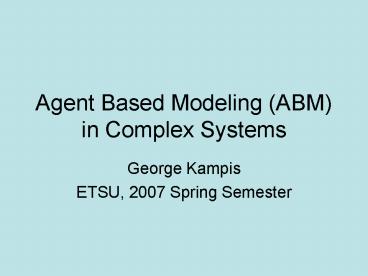Agent Based Modeling ABM in Complex Systems - PowerPoint PPT Presentation
1 / 22
Title:
Agent Based Modeling ABM in Complex Systems
Description:
Classes of Complexity. Warren Weaver 1968. Organized simplicity (pendulum, oscillator) ... BZ -- http://www.hermetic.ch/pca/bz.htm. http://www.peak.org/~jeremy ... – PowerPoint PPT presentation
Number of Views:125
Avg rating:3.0/5.0
Title: Agent Based Modeling ABM in Complex Systems
1
Agent Based Modeling (ABM)in Complex Systems
- George Kampis
- ETSU, 2007 Spring Semester
2
Complexity in Physics and Biology
- Complexity in Physics
- Nonlinearity (small change yields big change
- Dynamics based (ODE, PDE, map)
- Exotic behavior and unpredictability
- Chaos
- Catastrophy
- Fractals
- Etc.
3
Chaos
4
Catastrophe
x3 - bx - a 0
5
Fractals
6
Patterns in Biology
7
Classes of Complexity
- Warren Weaver 1968
- Organized simplicity (pendulum, oscillator)
- Disorganized complexity (statistical systems)
- Organized complexity
- Heterogeneity, many components
8
The road to ABM
- Cellular automata
- Multi-agent systems, mobile agents, etc.
- ABM methodology
9
Cellular automata (CA)
10
Conways Life Game
- http//en.wikipedia.org/wiki/Conway's_Game_of_Life
Objects, computation, Self-Reproduction,
evolution..
11
Physics in CA
Digital ink
Ulam, von Neumann
Toffoli
Fredkin
12
CA properties
- Local
- Individual based
- Bottom up
- But
- Homogeneous
- Limited interaction patterns
- Space oriented, not agent oriented
13
Predator-prey CA
- S. Karsai
- Colors code for state
- But state must be composite of objects
- As organized complexity increases gets
complicated or homogeneity lost
14
Complex Adaptive Systems (CAS)
- Biological systems are complex adaptive systems
(CAS). Complex systems are composed of many
components that interact dynamically so that the
system shows spontaneous self-organisation to
produce global, emergent structures and
behaviours. In biology, the nature of the
interactions themselves are often state- or
context-dependent so that systems are adaptive. A
'taxonomy of complexity' suggested by (Mitchell,
2003) captures well the complexity found in
Biology - Constitutive Complexity Organisms display
complexity in structure, the whole is made up of
numerous parts in non-random organisation. - Dynamic Complexity Organisms are complex in
their functional processes. - Evolved Complexity Alternative evolutionary
solutions adaptive problems, historically
contingent.
15
Multi-agent systems (MAS)
- Topics of research in MAS include
- beliefs, desires, and intentions (BDI),
- cooperation and coordination,
- organisation,
- communication,
- negotiation,
- distributed problem solving,
- multi-agent learning.
- scientific communities
- dependability and fault-tolerance
16
ABM classifications
- Do either or both of the following apply in the
model? - 1. The system can be decomposed into
subsystems/sub-models e.g. different metabolic
pathways, signalling networks. - 2. The model includes more than one level of
description (this can be across both spatial and
temporal scales) e.g. some parts of the model
given in terms of single molecules while other
parts given in terms of concentrations of these
same molecules? - System Organisation
- Can entities enter and leave the different
subsystems at different times? - Entities and their Behaviour
- 1. Do entities show discontinuous changes in
behaviour through their lifetime as part of their
development (pre-programmed rule changes) e.g.
stops growing after it has reached a certain age?
- 2. Do entities develop new types of
behaviour/capabilities in response to certain
conditions through its lifetime
17
Contd
- Entity Behaviour Which of the following affect
it at each time step? - The states of other entities in its neighbourhood
or group - Global state
- Local state (defined spatially)
- The Role of Space and Spatio-Temporal Dynamics
- 1. Are there locally defined state variables that
undergo evolution? - 2. Do physical-spatial interactions / motion need
to be modelled?
18
Contd
- Groups Groups can be used to relate subsets of
agents that interact with each other. The precise
nature of the interaction relationships between
agents in the same group depend on the model. - Organisational Metaphor with Dynamic Group
Structure In a dynamic group structure, agents
can enter and leave groups. Groups can also be
dynamic in the sense that they can exist and
cease to exist at different times. The
Agent-Group-Role formalism is an example of an
organisational metaphor that can cope with both
dynamic groups and dynamic participation. - Situated agents Agents are situated in some
environment and are located in space. There may
be several different ways of representing this
environment e.g. discrete grid, continuous space.
- Agents with pro-active behavioural rules Agents
have rules that arise from within themselves e.g.
rules governing development, random changes.
These rules can also interact with reactive
rules. - Agents with behavioural rules that are adaptive
Agent rules themselves can change through time.
19
Communication Templates
- Static Net
- Dynamic Net
- Agents Moving in Space
- Cellular Automaton (CA)
- Other Cases
20
ABM Simulations (in RePast)
21
Links 1
- Chaos --
- http//www.cmp.caltech.edu/mcc/Chaos_Course/Lesso
n1/Demo8.html - http//www.falstad.com/vector3d/
- Catasrophe --
- http//perso.orange.fr/l.d.v.dujardin/ct/eng_index
.html - http//perso.orange.fr/l.d.v.dujardin/ct/catastrop
he.htmlapplet - http//perso.orange.fr/l.d.v.dujardin/ct/cusp.html
- Fractals --
- http//www.softwarefederation.com/fractal.html
- http//www.geocities.com/CapeCanaveral/Hangar/7959
/fractalapplet.html - http//ejad.best.vwh.net/java/fractals/lsystems.sh
tml - http//www.h2database.com/fractals/
- http//spanky.triumf.ca/www/fractint/fractint.html
22
Links 2
- BZ --
- http//www.hermetic.ch/pca/bz.htm
- http//www.peak.org/jeremy/bz/bzstills.html
- CA ---
- http//www.psigenics.co.uk/cellularAutomata/Main.h
tml - http//www.ibiblio.org/lifepatterns/
- http//www.collidoscope.com/modernca/traditionalru
les.html - http//www.collidoscope.com/cgolve/welcome.html
- http//www.mirekw.com/ca/pow.html
- http//complex.upf.es/josep/CA.html
- http//www.economicsnetwork.ac.uk/cheer/ch17/hand.
htm































